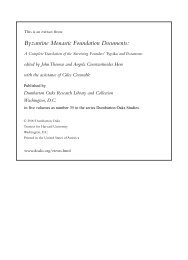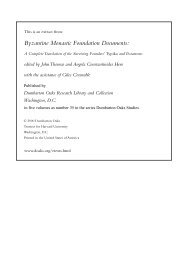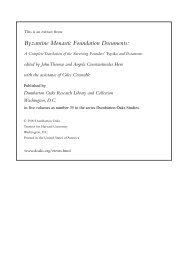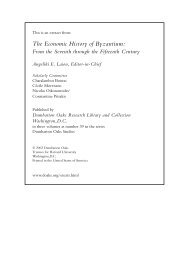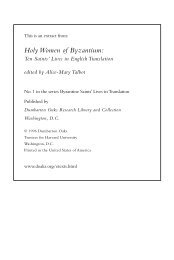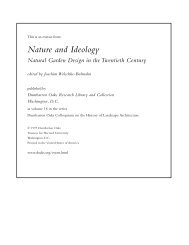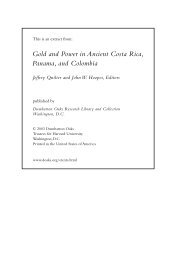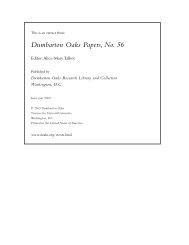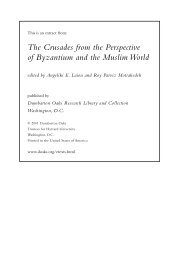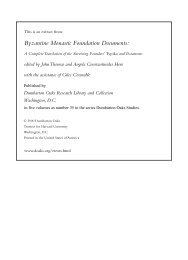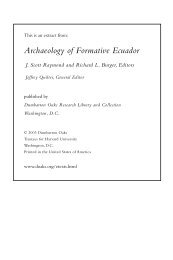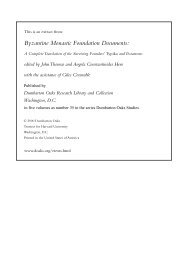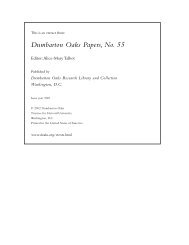3. Theodore Studites - Dumbarton Oaks
3. Theodore Studites - Dumbarton Oaks
3. Theodore Studites - Dumbarton Oaks
Create successful ePaper yourself
Turn your PDF publications into a flip-book with our unique Google optimized e-Paper software.
<strong>3.</strong> THEODORE STUDITES<br />
is mostly concerned about women in this connection [9], [15], [16], [17], although he also forbids<br />
the superior an adolescent disciple [18], and there is a curious prohibition of female domestic<br />
animals [5] (to be repeated in (13) Ath. Typikon [31] and elsewhere). 35 Maintenance of sexual<br />
segregation evidently was difficult, especially in an urban and aristocratic milieu, and <strong>Theodore</strong><br />
explicitly allows for exceptions [16]. Total segregation (as espoused later by (42) Sabas) was not<br />
thought to be practical.<br />
B. Constitutional Matters<br />
The transmission of the monastery, the principal concern of (1) Apa Abraham, is our author’s first<br />
concern here too after his profession of faith. <strong>Theodore</strong> exercises his patronal right to appoint his<br />
successor (not named, but known to be his disciple Naukratios). Subsequent superiors were to be<br />
chosen by the community, a common arrangement in medieval Byzantium which had the effect of<br />
lessening patronal influence after the next generation (cf. the arrangements in (10) Eleousa [16],<br />
cf. [11]).<br />
An important theme in <strong>Theodore</strong>’s admonitions to the superior is his concern, shared with the<br />
author of (1) Apa Abraham [5], that the superior not permit the monastery’s resources to fall into<br />
the hands of outsiders; to this he adds the injunction that the superior not misuse the monastery’s<br />
property for his own use either [3]. This reflects a strengthening of the notion of institutional<br />
integrity even within the context of private ownership.<br />
It is important to view this document in the context of its association with a private religious<br />
foundation whose claim to independence from state control <strong>Theodore</strong> had been able to uphold<br />
with only partial success during his lifetime. Indeed, he had lost the Stoudios monastery itself,<br />
originally a gift from Empress Irene that her successors felt free to revoke twice, in 809 and in<br />
815. In addition to confiscation, secularization was another threat, particularly during the bitter<br />
iconoclastic controversy in which <strong>Theodore</strong> and his monks had generally stood in opposition to<br />
imperial policy. Even aside from the extraordinary dangers of the times, for a superior of noble<br />
birth, kinship ties posed potential conflicts of interest [8]. The superior is explicitly told not to<br />
prefer eminent and powerful persons to the interests of the community [23].<br />
Philosophically, <strong>Theodore</strong> preferred a consultative to an authoritarian style of rule, if not for<br />
himself (which seems doubtful), then at least for his successors. Accordingly, the superior was to<br />
supervise [22] the performance of the monks in various offices in conjunction with the “foremost<br />
brothers.” Generally speaking, he was not to act [24] in any area without consulting with “those<br />
who are foremost in knowledge and prudence regarding the issue in question.” <strong>Theodore</strong> even<br />
suggests [25] that the community itself is the ultimate source of authority within the institution by<br />
virtue of the fact that the monks have assented to the choice of their leader.<br />
C. Financial Matters<br />
Though there is no direct testimony, it would appear that the monastery itself was supported by the<br />
income from a landed endowment [4], cf. [21], worked, evidently, by free labor, since both agricultural<br />
and personal slaves are explicitly forbidden. Nothing is said about any manual labor<br />
engaged in by the monks, though we know from other sources that monks were engaged in agricultural<br />
labors at the Studite monasteries outside Constantinople, though not at Stoudios itself. 36<br />
[ 71 ]




